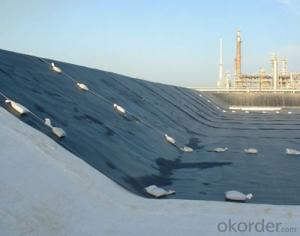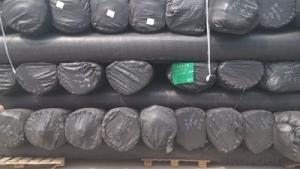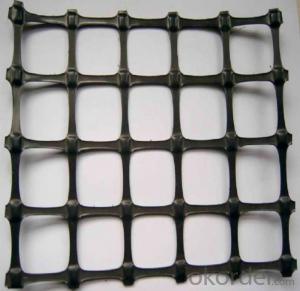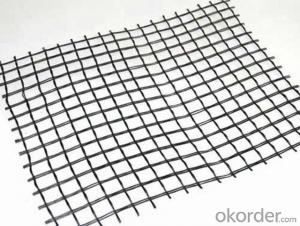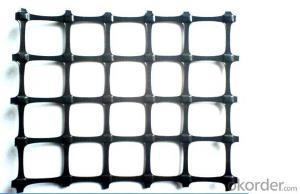Normal HDPE Geomembrane for Environmental Projects water conservancy projects landfill
- Loading Port:
- Tianjin
- Payment Terms:
- TT OR LC
- Min Order Qty:
- 88 m²
- Supply Capability:
- 1800000 m²/month
OKorder Service Pledge
OKorder Financial Service
You Might Also Like
Normal HDPE Geomembrane for river pool highway project
Made from MDPE and HDPE resin by blow film process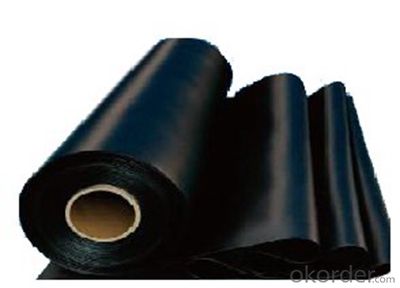 Specification of Normal HDPE Geomembrane for river pool highway project:
Specification of Normal HDPE Geomembrane for river pool highway project:
1. Thickness: 0.3mm-3. Omm
2.4m-9m in roll width, the length as client ' s request
Property of Normal HDPE Geomembrane for river pool highway project:
I. Excellent environmental stress cracking resistance property
2. Low temperature resistance, corrosion resistance, aging resistance
3. For service temperature range: -600C-+600C
4. Service valid term: 60 years at least
Application of Normal HDPE Geomembrane for river pool highway project:
L. Municipal environmental projects, water conservancy projects
2. Anti-seepage p rojects for transportation infrastructu re
3. AG ricultu ral water conserva ncy proj ects
4. Water proof engineering for aquaculture, Irrigation ditch, ponds and reservoir
5. Anti-seepage projects for tunnel, chemical pool, buildings
Production standard of Normal HDPE Geomembrane for river pool highway project:
1. GB/T17643-2011
2JT/T 518-2004
Area |
|
Hydraulic | Lagooning and Water Treatment, Ornamental Ponds, Golf Courses Aquaculture and Desalination Water LagoonsTanks, Reservoirs, Liquid WasteFloating Cover SolutionsDrainage and FiltrationShading Cover Solutions |
Environment | Tailing ponds, Leach mining,Landfills,Landfill Capping,Protection against corrosion,Vertical Barriers |
Civil Works | Erosion Control, Secondary Containment, Tunnels,Linear and Surface Works,Consolidation of Margins,Soil Reinforcement,Soil Separation. |
Building | Parkings,Roofing,Soundproofing building |
Introduction of CNBM
China National Building Materials (Group) Corporation (CNBM) is a state-owned enterprise in charge of administrative affairs in China building materials industry. Established in 1984, CNBM is a large group corporation of building materials with total assets of RMB 25 billion and a total staff of 30,000. Now CNBM owns more than 200 subsidiaries in and abroad the country, including wholly-owned corporations and joint ventures.
FAQ of geosynthetics :
What is geosynthetics ?
Geosynthetics form a perfect erosion control fabric used extremely widely in civil engineering to stabilize and reinforce slopes and soil under or next to roads, railways, dams, water reservoirs etc.. They can be easily applied which minimizes the time of construction, as well as they limit the resources and materials necessary.
What kinds of geosynthetics we have ?
Non-woven geotextile, geogrids, geocells, GCL, Geomembranes, Geonets, Geocomposites etc .
What is the geosynthetics used for ?
Hydraulic
Lagooning and Water Treatment, Ornamental Ponds, Golf Courses
Aquaculture and Desalination,Water Lagoons,Tanks, Reservoirs, Liquid Waste,Floating Cover Solutions, Drainage and Filtration
Environment
Tailing ponds, Leach mining,Landfills,Landfill Capping,Protection against corrosion,Vertical Barriers
Civil Works
Erosion Control,Secondary Containment,Tunnels,Linear and Surface Works,Consolidation of Margins,Soil Reinforcement,Soil Separation.
Building - Parkings,Roofing,Soundproofing
- Q:Can geogrids be used in reinforcement of underground pipelines?
- Yes, geogrids can be used in the reinforcement of underground pipelines. Geogrids are commonly used in civil engineering applications to improve the strength and stability of soil. By placing geogrids around underground pipelines, they can effectively distribute the stress and reduce the potential for deformation or failure of the pipelines. Additionally, geogrids can also help to prevent soil erosion and provide long-term reinforcement to ensure the integrity of the underground pipeline system.
- Q:Can geogrids be used in retaining wall reinforcement systems?
- Yes, geogrids can be used in retaining wall reinforcement systems. Geogrids are commonly used to enhance the stability and strength of retaining walls by improving soil retention and reducing lateral pressure. They provide additional support to the wall structure and prevent soil erosion, helping to increase the overall durability and longevity of the retaining wall.
- Q:Are geogrids resistant to chemical attack from soil contaminants?
- Yes, geogrids are generally resistant to chemical attack from soil contaminants. Due to their high tensile strength and chemical stability, geogrids can withstand exposure to various soil contaminants without significant deterioration. However, the specific resistance may vary depending on the type of geogrid material and the nature of the soil contaminants.
- Q:Do geogrids affect groundwater flow?
- No, geogrids do not affect groundwater flow.
- Q:Can geogrids be used in reinforced earth bridge abutments?
- Yes, geogrids can be used in reinforced earth bridge abutments. Geogrids are commonly used in the construction of bridge abutments as they provide reinforcement and stabilization to the soil. They help distribute the load and increase the overall strength of the structure, making it more resistant to settlement and lateral forces. Geogrids are an effective solution for enhancing the stability and durability of reinforced earth bridge abutments.
- Q:Are geogrids suitable for use in soil reinforcement for bridge abutments?
- Yes, geogrids are suitable for use in soil reinforcement for bridge abutments. Geogrids offer a cost-effective solution to improve the strength and stability of soil, preventing erosion and settlement. They provide excellent tensile strength and interlocking capabilities to distribute loads, making them effective in reinforcing bridge abutments and enhancing their performance.
- Q:What is the effect of junction strength on geogrid performance?
- The junction strength of a geogrid directly impacts its performance. A higher junction strength enhances the overall stability and load-bearing capacity of the geogrid, allowing it to effectively restrain soil movement and distribute loads. It also improves the geogrid's resistance to deformation, puncture, and tearing. In summary, a strong junction enhances the geogrid's effectiveness and durability in various geotechnical applications.
- Q:How do geogrids enhance the performance of reinforced soil slopes?
- Geogrids enhance the performance of reinforced soil slopes by providing additional strength and stability to the soil mass. They act as a reinforcing element by distributing the load and reducing the potential for soil erosion and sliding. Geogrids also increase the bearing capacity of the slope, allowing for steeper slopes to be constructed.
- Q:Do geogrids increase the bearing capacity of soil?
- Yes, geogrids can increase the bearing capacity of soil. Geogrids are materials made of polymers or metals that are used to reinforce soil. They help distribute the load more evenly, reducing the stress on the soil and increasing its ability to bear heavier loads.
- Q:What are the advantages of using geogrids in ground improvement for slope stabilization?
- Geogrids offer several advantages when used in ground improvement for slope stabilization. Firstly, they enhance the tensile strength of the soil, providing reinforcement against slope movement and potential failure. Secondly, geogrids distribute the load more evenly, reducing stress concentrations and preventing localized failures. Additionally, these materials are easy to install and cost-effective, making them a practical solution for stabilizing slopes. They also allow for better drainage, reducing the risk of water accumulation and associated erosion. Overall, geogrids provide a reliable and efficient method for enhancing slope stability and reducing the risk of slope failure.
1. Manufacturer Overview |
|
|---|---|
| Location | |
| Year Established | |
| Annual Output Value | |
| Main Markets | |
| Company Certifications | |
2. Manufacturer Certificates |
|
|---|---|
| a) Certification Name | |
| Range | |
| Reference | |
| Validity Period | |
3. Manufacturer Capability |
|
|---|---|
| a)Trade Capacity | |
| Nearest Port | |
| Export Percentage | |
| No.of Employees in Trade Department | |
| Language Spoken: | |
| b)Factory Information | |
| Factory Size: | |
| No. of Production Lines | |
| Contract Manufacturing | |
| Product Price Range | |
Send your message to us
Normal HDPE Geomembrane for Environmental Projects water conservancy projects landfill
- Loading Port:
- Tianjin
- Payment Terms:
- TT OR LC
- Min Order Qty:
- 88 m²
- Supply Capability:
- 1800000 m²/month
OKorder Service Pledge
OKorder Financial Service
Similar products
New products
Hot products
Hot Searches
Related keywords
